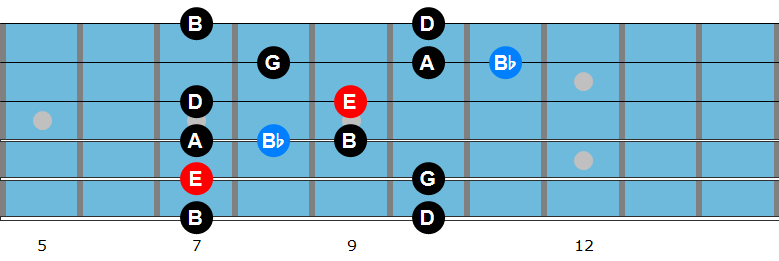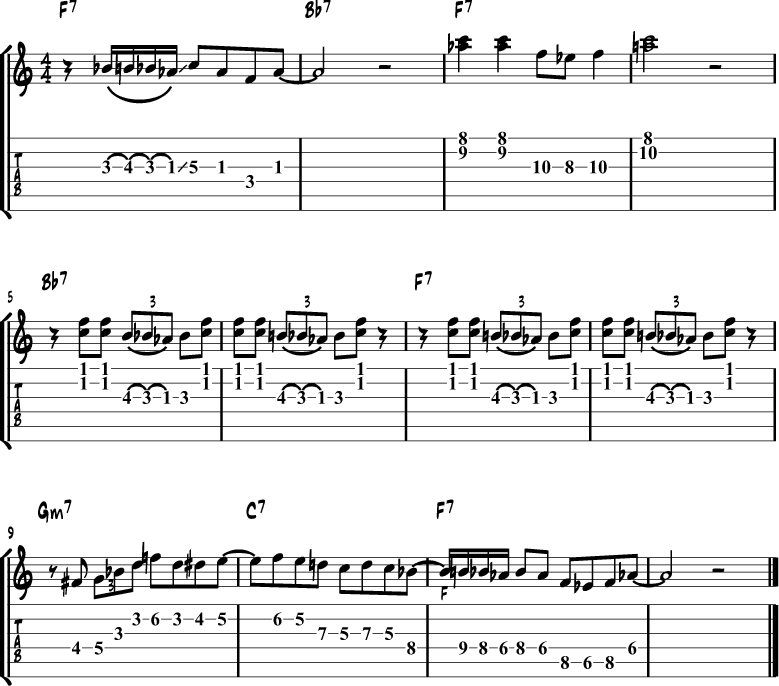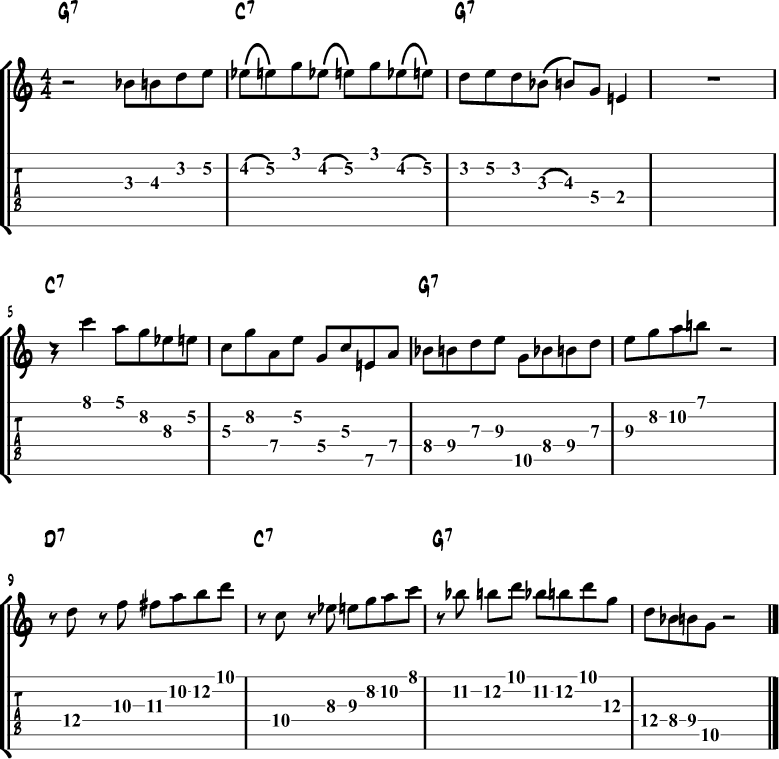The blues scale is one of the first guitar scales we explore on the guitar when learning how to solo. The scale is used in many different styles of music, such as rock, blues, and jazz. There are 2 kinds of blues scales: the minor blues scale and the major blues scale.
The blues scale can be heard in legendary solos from players such as Wes Montgomery, Kenny Burrell, George Benson, and many more.
Because of this, this scale is essential learning for anyone studying jazz guitar and jazz guitar improvisation.
Both the minor and major blues scale are hexatonic, which means they contain 6 notes.
The Minor Blues Scale
The minor blues scale is one of the most versatile scales that you can use in your guitar solos. It is fairly easy to finger on the guitar, fun to solo with and a great way to begin playing in a jazz guitar setting.
In this section you will learn how to build, play, practice, and solo with the minor blues scale in a jazz setting, as well as check out a sample solo to help you bring this scale from the page and onto the fretboard in your practice routine.
Minor Blues Scale Construction
To begin, let’s look at the interval structure of the minor blues scale.
The minor blues scale is related to the natural minor scale and the minor pentatonic scale.
The natural minor scale (aka Aeolian scale) has 7 notes. The minor pentatonic scale consists of 5 of these notes (1, b3, 4, 5 and b7).
You can also think of the minor blues scale as a minor pentatonic scale with an added b5 note. This added note is often referred to as the blue note. This blue note characterizes the minor blues scale and sounds very bluesy when applied to your jazz guitar soloing lines.

Minor blues scale = minor pentatonic scale + blue note b5
| F Minor Blues Scale | F | Ab | Bb | B | C | Eb |
|---|---|---|---|---|---|---|
| 1 | b3 | 4 | b5 | 5 | b7 |
Here is how the F minor blues scale looks in tabs:

How to Use the Minor Blues Scale?
Since the minor blues scale is built by adding one note to the minor pentatonic scale, you can use this scale to solo over similar harmonies as the minor pentatonic scale.
Here is a list of chords that you can apply the minor blues scale to:
- Major triads
- Major 7th chords
- Dominant 7th chords
- Minor triads
- Minor 7th chords
As you can see, the minor blues scale is a very versatile scale.
You can also use it to outline entire keys such as playing an F minor blues scale over a blues in F chord progression, as well as a number of individual chords as listed above.
Minor Blues Scale Diagrams
Here are the 5 common fingerings for this scale on the fretboard of the guitar, presented here in the key of F.
Work on each shape slowly with a metronome in multiple keys across the neck as you memorize each shape and get the sound of this scale into your ears, as well as each shape under your fingers.

After you have worked out one of these patterns, try putting on an F7 backing track and solo over that chord using one of these minor blues scale fingerings as the basis for your lines.
When you have worked two fingerings on their own, combine these two patterns in your soloing exercise and continue to work each scale fingering in this manner until you’ve worked out all 5.
You can then take this exercise to other 7th chords in your practice routine in order to ensure that you learn these fingerings from a technical standpoint, but in an improvisational context as well.
Minor Blues Scale Jazz Licks
To help you take this scale from the technical side of your practice routine to the improvisational, here are 8 classic sounding blues scale licks that you can work on in 12 keys.
Minor Blues Scale Lick 1
This first lick is in the key of A minor and uses the first shape of the A minor blues scale.


Minor Blues Scale Lick 2
The next lick is in the key of B minor and uses the 5th shape of the B minor blues scale.


Minor Blues Scale Lick 3
The third lick is in the key of E minor and uses the 4th shape of the E minor blues scale.


Minor Blues Scale Lick 4
The following 5 licks all use the F minor blues scale over an F dominant chord.
Listen & Play Along

Minor Blues Scale Lick 5
Listen & Play Along

Minor Blues Scale Lick 6
Listen & Play Along

Minor Blues Scale Lick 7
Listen & Play Along

Minor Blues Scale Lick 8
Listen & Play Along

Minor Blues Scale Solo
To finish our intro to the minor blues scale, here is a sample solo over an F blues. You can use the F minor blues scale over the entire blues chord changes.
Listen & Play Along

Learn jazz blues guitar step-by-step, download our ebook Introduction to Jazz Blues Guitar
The Major Blues Scale
Just as its minor sibling, the major blues scale is an important melodic device that you can use to solo in many different musical situations and genres.
Major Blues Scale Construction
Let’s look at how to build this scale and how it is related to the major scale and the major pentatonic scale.
As you can see below, the major scale has 7 notes. The major pentatonic scale is made up of five of those notes (1, 2, 3, 5, and 6 of the major scale).
To produce a major blues scale, you simply take the major pentatonic scale and add in a blue note, the b3 of the key. This added note gives the major blues scale its bluesy vibe and separates it melodically from the major pentatonic scale.

Major blues scale = major pentatonic scale + blue note b3
| G Major Blues Scale | G | A | Bb | B | D | E |
|---|---|---|---|---|---|---|
| 1 | 2 | b3 | 3 | 5 | 6 |
Here is a sample two-octave fingering for the G major blues scale. Get it under your fingers so that you can begin to visualize this scale on the fretboard, and hear how it sounds on your guitar.

How to Use the Major Blues Scale?
There are two ways you can use the major blues scale in your solos:
- To outline maj7 chords (+ maj9 and maj6).
- To outline 7th chords (+ 9th and 13th chords).
The major blues scale works over both major 7 and dominant 7 based chords. This is because there is a major triad in the scale, but no 7th.
The 6th note of the scale can act to produce:
- Maj6 sounds over a major-type chord.
- 13 sounds over a dominant-type chord.
Major Blues Scale vs Minor Blues Scale
The main difference between the use of major and minor blues scales is that as the chords change in a blues or other standard form, you have to change scales along with them.
In a I-IV-V blues in the key of G (see in the last example of this lesson), you can play:
- a G minor blues scale throughout the entire form, or
- a G, C and D major blues scale for each of the three chords in the tune (G7-C7-D7).
This is the hardest part about learning to use the major blues scale.
The fingerings of the major blues scale resemble fingerings that you may already know for the minor blues scale but starting on different notes. This is the main issue players usually find when working on this scale, that it looks like the minor blues scale but isn’t played from the same root notes.
C major blues scale = A minor blues scale
The notes of the C major blues scale (C D Eb E G A) are the same as the notes from the A minor blues scale (A C D Eb E G), but they start on a different note and are used in another way.
So, make sure that you differentiate the major from the minor blues scales in your practicing so that they are distinct and easy to move between when you apply them to your jazz guitar solos.
Major Blues Scale Diagrams
There are 5 main fingerings for the major blues scale. Here are the scale diagrams for a G major blues scale.

Major Blues Scale Licks
To help you get started with the major blues scale, and learn how to apply it to soloing situations, here are a few sample licks that you can learn, work in 12 keys, and use as the basis for your own lines.
Major Blues Scale Lick 1
This first lick is one of the most commonly used licks built from this scale.
To really get this lick into the swing style, try and accent the first and last note (play them louder) of the lick. This will bring an emphasis to the outer notes of the lick, and add an extra layer of rhythmic interest to the line itself.
Listen & Play

Major Blues Scale Lick 2
The next major blues scale lick is based on a three-note repeated pattern (the b3-3-5 of the chord), that is reminiscent of the jazz guitar solos of Pat Martino.
Because the pattern is 3 notes long but played in an 8th-note rhythm, you are syncopating the lick so that it starts on a different part of the bar each time. This allows you to build energy in your solo, as well as use a repeated lick without it sounding boring.
Listen & Play

Major Blues Scale Lick 3
This last lick is over C7 and uses the C major blues scale.


Major Blues Scale Sample Solo
Here is a sample solo over a G blues chord progression. Start by playing the solo as written.
Then, play the first 8 bars as written and improvise the last 4 bars. From there, play the first 4 bars as written, and improvise the last 8 bars, before moving on to a fully improvised solo after that. This kind of transitional exercise is a great way to learn vocabulary, and integrate it into your playing at the same time.
Listen & Play

How do you use the blues scale in your jazz solos? Let us know in the comments below…
More Guitar Scale Lessons
The post Blues Scales – The Major and Minor Blues Scale appeared first on Jazz Guitar Online | Free Jazz Guitar Lessons, Licks, Tips & Tricks..
from Jazz Guitar Online | Free Jazz Guitar Lessons, Licks, Tips & Tricks. https://ift.tt/2wPNauF

No comments:
Post a Comment